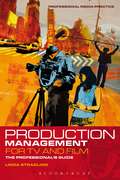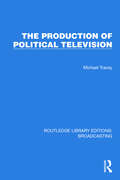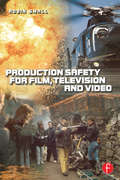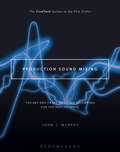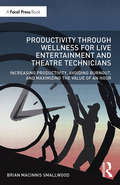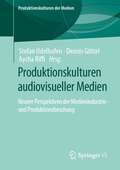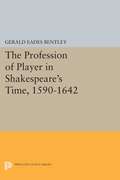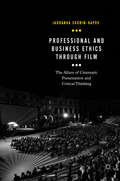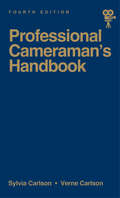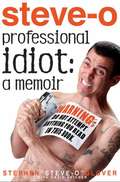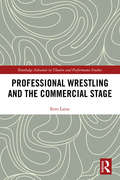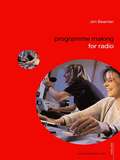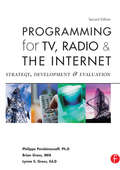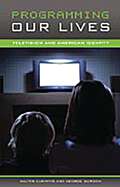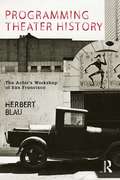- Table View
- List View
Production Management for TV and Film: The professional's guide (Professional Media Practice)
by Linda Stradling"What Linda Stradling doesn't know about production management isn't worth knowing" The Documentary Filmmakers GroupPlaying a key role in helping producers to interpret and realise the directors' vision, production managers are responsible for all organisational aspects of TV and film production - from start to finish. Now this essential handbook tells you how it's done. Written by highly experienced production manager and specialist tutor, Linda Stradling, this is a complete guide to the profession. It includes details on self-organisation and the best systems to use, budgets, schedules and cost control, hiring and firing, contracts, insurance, setting up a shoot, dealing with contributors, acquiring copyright, people skills and ethics. So whether you're just starting out or want to improve your knowledge and skills, this is the book for you.
Production Management for TV and Film: The professional's guide (Professional Media Practice)
by Linda Stradling"What Linda Stradling doesn't know about production management isn't worth knowing" The Documentary Filmmakers GroupProduction Managers are responsible for all the organisational aspects of a TV or film production such as scheduling and budgeting and assisting producers to interpret and realise the directors' vision. Linda Stradling is a highly experienced production manager and trainer. Her book is based on her training handouts and notes and offers a complete `manual' to the role including: self organisation and systems to use, budgets, schedules and cost control, cash flow, hiring and firing, contracts, insurance, health and safety, setting up an efficient and cost-effective shoot, dealing with contributors, acquiring copyright, sourcing CGI, editors, music cue sheets, deliverables, people skills and ethics. A chapter contribution is included from leading drama production manager Julie Clark (currently line producer on Glorious 39, Stephen Poliakoff's new film). Written by an industry insider, this is an exhaustive manual to every aspect of the job, with reference material and real-life examples. Essential paperwork and sample budgets can also be found on our website. A complete on-the-job reference tool.
The Production of Political Television (Routledge Library Editions: Broadcasting #29)
by Michael TraceyThe Production of Political Television (1977) is a study of the organization and methods of production of political television that covers not only news broadcasts and current affairs programmes but all programmes involved with the policy making process in Britain. It examines the procedures by which producers put their programmes together, and analyses the impact of external institutions on the programme-making process.
The Production of Political Television (Routledge Library Editions: Broadcasting #29)
by Michael TraceyThe Production of Political Television (1977) is a study of the organization and methods of production of political television that covers not only news broadcasts and current affairs programmes but all programmes involved with the policy making process in Britain. It examines the procedures by which producers put their programmes together, and analyses the impact of external institutions on the programme-making process.
Production Safety for Film, Television and Video
by Robin SmallCovering all aspects of production safety, this is an invaluable reference guide for the independent programme maker, freelancer, manager, producer, tutor and student filmmaker. Robin Small identifies all the major risks and gives advice on how to control and/or eliminate them. Each hazard section includes useful references to the relevant legislation, documents and licences, as well as addresses of organisations for essential advice and recommended further reading. An appendix lists samples of vital certificates, with visual references provided on www.focalpress.com. Important information about hazard identification, risk assessment and safety policy is provided in the chapters covering legislation, health and safety management, personal protective equipment and insurance. Particular hazards are then split into individual sections for ease of reference. These hazards include:AsbestosCranesExplosives and pyrotechnicsFood and cateringManual handing and liftingVisual display screensWorking at heightsThe appendices provide comprehensive contact information for UK and European Heath and Safety sources. They also include sample forms to draw up your own safety system.Robin Small is Senior Lecturer in Television, Media Department at the University of Huddersfield.
Production Safety for Film, Television and Video
by Robin SmallCovering all aspects of production safety, this is an invaluable reference guide for the independent programme maker, freelancer, manager, producer, tutor and student filmmaker. Robin Small identifies all the major risks and gives advice on how to control and/or eliminate them. Each hazard section includes useful references to the relevant legislation, documents and licences, as well as addresses of organisations for essential advice and recommended further reading. An appendix lists samples of vital certificates, with visual references provided on www.focalpress.com. Important information about hazard identification, risk assessment and safety policy is provided in the chapters covering legislation, health and safety management, personal protective equipment and insurance. Particular hazards are then split into individual sections for ease of reference. These hazards include:AsbestosCranesExplosives and pyrotechnicsFood and cateringManual handing and liftingVisual display screensWorking at heightsThe appendices provide comprehensive contact information for UK and European Heath and Safety sources. They also include sample forms to draw up your own safety system.Robin Small is Senior Lecturer in Television, Media Department at the University of Huddersfield.
Production Sound Mixing: The Art and Craft of Sound Recording for the Moving Image (The CineTech Guides to the Film Crafts)
by John J. MurphyThe latest hot camera is pretty irrelevant if one can't understand what's happening on screen. The key to any narrative is in the dialogue and voice over, but if this is unintelligible or difficult to hear, viewers will soon lose interest. With real world applications and a narrative to keep the reader's interest, Production Sound Mixing is the indispensable guide for film and video audio recording. Written by veteran sound mixer John J. Murphy, the book offers a step by step collaborative journey through the basic physics of sound, concluding with a practical guide of the latest techniques and equipment available to all who are interested in the best audio for their projects. Structured to mimic a 14-week semester, each chapter begins with an audio problem to be solved and ends with a solution drawn from information gleaned from past chapters. Suggested movie scenes that demonstrate the relevant audio techniques will also be included. Equally applicable to studio and location recording, the book is oriented toward commonly accessible environments such as conference rooms, hallways, beaches, car interiors, bathrooms, and so on. The intent is to allow the student to make the best of a location no matter how challenging it might be. Most importantly, this book will make one aware of the potential of sound on screen, for it is truly 50% of the viewing experience.
Production Sound Mixing: The Art and Craft of Sound Recording for the Moving Image (The CineTech Guides to the Film Crafts)
by John J. MurphyThe latest hot camera is pretty irrelevant if one can't understand what's happening on screen. The key to any narrative is in the dialogue and voice over, but if this is unintelligible or difficult to hear, viewers will soon lose interest. With real world applications and a narrative to keep the reader's interest, Production Sound Mixing is the indispensable guide for film and video audio recording. Written by veteran sound mixer John J. Murphy, the book offers a step by step collaborative journey through the basic physics of sound, concluding with a practical guide of the latest techniques and equipment available to all who are interested in the best audio for their projects. Structured to mimic a 14-week semester, each chapter begins with an audio problem to be solved and ends with a solution drawn from information gleaned from past chapters. Suggested movie scenes that demonstrate the relevant audio techniques will also be included. Equally applicable to studio and location recording, the book is oriented toward commonly accessible environments such as conference rooms, hallways, beaches, car interiors, bathrooms, and so on. The intent is to allow the student to make the best of a location no matter how challenging it might be. Most importantly, this book will make one aware of the potential of sound on screen, for it is truly 50% of the viewing experience.
Productivity Through Wellness for Live Entertainment and Theatre Technicians: Increasing Productivity, Avoiding Burnout, and Maximizing the Value of An Hour
by Brian MacInnis SmallwoodProductivity Through Wellness for Live Entertainment and Theatre Technicians provides the tools for individuals and organizations to achieve a healthy work–life balance and increase productivity in the production process of live entertainment. Through examination of the limits of the human body, the fundamentals of motivation, and best practices of project management, the reader will develop operational mindfulness and look at new ways to achieve work–life balance. The book explores case studies that show how organizations are promoting work–life balance and reaping the benefits of increased productivity, makes recommendations to reduce burnout and increase productivity among technicians, and discusses how to deal with the various phases of production. An excellent resource for live entertainment technicians, production managers, technical directors, arts managers, managers in live entertainment, and students in Technical Direction and Production Management courses, Productivity Through Wellness for Live Entertainment and Theatre Technicians offers practical solutions to improve the quality of life of employees, reduce the burnout and injuries of overwork, and maximize the value of an hour.
Productivity Through Wellness for Live Entertainment and Theatre Technicians: Increasing Productivity, Avoiding Burnout, and Maximizing the Value of An Hour
by Brian MacInnis SmallwoodProductivity Through Wellness for Live Entertainment and Theatre Technicians provides the tools for individuals and organizations to achieve a healthy work–life balance and increase productivity in the production process of live entertainment. Through examination of the limits of the human body, the fundamentals of motivation, and best practices of project management, the reader will develop operational mindfulness and look at new ways to achieve work–life balance. The book explores case studies that show how organizations are promoting work–life balance and reaping the benefits of increased productivity, makes recommendations to reduce burnout and increase productivity among technicians, and discusses how to deal with the various phases of production. An excellent resource for live entertainment technicians, production managers, technical directors, arts managers, managers in live entertainment, and students in Technical Direction and Production Management courses, Productivity Through Wellness for Live Entertainment and Theatre Technicians offers practical solutions to improve the quality of life of employees, reduce the burnout and injuries of overwork, and maximize the value of an hour.
Produktionskulturen audiovisueller Medien: Neuere Perspektiven der Medienindustrie- und Produktionsforschung (Produktionskulturen der Medien)
by Stefan Udelhofen Dennis Göttel Aycha RiffiAls eine der wenigen, deutschsprachigen Überblicksdarstellungen zum interdisziplinären Feld der Production Studies bzw. der Cultural Studies of Media Industries, versammelt der Band aktuelle Beiträge der sozial- und kulturwissenschaftlichen Erforschung von audiovisuellen Medienindustrien in Geschichte und Gegenwart. Neben der Präsentation neuer Erkenntnisse liegt der Schwerpunkt der Beiträge insbesondere auf der theoretischen, methodischen und forschungspraktischen Reflexion, um eine weitergehende Verankerung dieses Forschungsfeldes im deutschsprachigen Raum voranzutreiben.
The Profession of Player in Shakespeare's Time, 1590-1642
by Gerald Eades BentleyThis book is a comprehensive study of the customary practices of English players of the period--how they lived and worked and were paid, organized, and cast for parts in the phenomenally popular theaters of England. Gerald Bentley discusses sharers, hired men, boy apprentices, musicians, touring groups, and managers, showing that players in general led difficult but seriously professional lives.Originally published in 1984.The Princeton Legacy Library uses the latest print-on-demand technology to again make available previously out-of-print books from the distinguished backlist of Princeton University Press. These editions preserve the original texts of these important books while presenting them in durable paperback and hardcover editions. The goal of the Princeton Legacy Library is to vastly increase access to the rich scholarly heritage found in the thousands of books published by Princeton University Press since its founding in 1905.
Professional and Business Ethics Through Film: The Allure of Cinematic Presentation and Critical Thinking (Palgrave Studies In Business, Arts And Humanities Ser.)
by Jadranka Skorin-KapovThis book considers ethical issues arising in professional and business settings and the role of individuals making decisions and coping with moral dilemmas. Readers can benefit from engagement in filmic narratives, as a simulated environment for developing a stance towards ethical challenges. The book starts by elaborating on critical thinking and on normative ethical theories, subsequently presenting the structure and cinematic elements of narrative film. These two avenues are tools for evaluating films and for discussions on various ethical problems in contemporary business, including: the corporate and banking financial machinations (greed, fraud, social responsibility); workplace ethical challenges (harassment, violence, inequity, inequality); professional and business ethical challenges (corruption, whistleblowing, outsourcing, downsizing, competition, and innovation); environmental and social issues; international business and human rights; and personal responsibility and identity challenges due to career pressures, loss of privacy and cyber harassment, and job structure changes in light of changing technology.
Professional and Business Ethics Through Film: The Allure of Cinematic Presentation and Critical Thinking
by Jadranka Skorin-KapovThis book considers ethical issues arising in professional and business settings and the role of individuals making decisions and coping with moral dilemmas. Readers can benefit from engagement in filmic narratives, as a simulated environment for developing a stance towards ethical challenges. The book starts by elaborating on critical thinking and on normative ethical theories, subsequently presenting the structure and cinematic elements of narrative film. These two avenues are tools for evaluating films and for discussions on various ethical problems in contemporary business, including: the corporate and banking financial machinations (greed, fraud, social responsibility); workplace ethical challenges (harassment, violence, inequity, inequality); professional and business ethical challenges (corruption, whistleblowing, outsourcing, downsizing, competition, and innovation); environmental and social issues; international business and human rights; and personal responsibility and identity challenges due to career pressures, loss of privacy and cyber harassment, and job structure changes in light of changing technology.
Professional Cameraman's Handbook, The
by Sylvia E Carlson Verne CarlsonThis new edition of an all-time best-seller is completely revised and updated and details the components and step-by-step use of over forty of the most widely used film cameras. Significant new topics include time code and time code slates, video assist, and the Steadicam film stabilizing system. Among a few of the new camera systems are the Aaton 16mm; Arriflex 535, 35-3, 35-BL3 and -BL4, and 16BL; Fries 35R3; and the all new Panavision Panaflex 35mm and 16mm. The book teaches basic film camera procedures and troubleshooting techniques. It also looks at all the components, accessories (including lenses), and support systems.
Professional Cameraman's Handbook, The
by Sylvia E Carlson Verne CarlsonThis new edition of an all-time best-seller is completely revised and updated and details the components and step-by-step use of over forty of the most widely used film cameras. Significant new topics include time code and time code slates, video assist, and the Steadicam film stabilizing system. Among a few of the new camera systems are the Aaton 16mm; Arriflex 535, 35-3, 35-BL3 and -BL4, and 16BL; Fries 35R3; and the all new Panavision Panaflex 35mm and 16mm. The book teaches basic film camera procedures and troubleshooting techniques. It also looks at all the components, accessories (including lenses), and support systems.
Professional Idiot: A Memoir
by Stephen Steve-O Glover"It's mind-blowing to me how utterly far gone Steve-O was, and how he looks back on it in this book with such intelligence, humor, and searing honesty. What a truly unbelievable life."--Johnny KnoxvilleFrom his early days videotaping crazy skateboard stunts to starring in the Jackass movies, there was little that Stephen "Steve-O" Glover wouldn't do. Whether it was stapling his nutsack to his leg or diving into a pool full of elephant crap, almost nothing was out of bounds. As the stunts got crazier, his life kept pace. He developed a crippling addiction to drugs and alcohol, and an obsession with his own celebrity that proved nearly as dangerous. Only an intervention and a visit to a psychiatric ward saved his life. Today he has been clean and sober for more than three years.Professional Idiot recounts the lunacy, the debauchery, the stunts, the drug addiction, and the path to recovery with bravado, humor, and heart."A great book to read before you get on the roller coaster to hell, if you plan on surviving to tell about it like Steve-O did."--Nikki Sixx, author of The Heroin Diaries"This is the perfect book for people who hate reading."--Tommy Lee, author of TommylandThe feedback I've gotten on Facebook and Twitter from those of you who've read this book has been fascinating, heartwarming, and hilarious. I'm happy to keep answering your questions on there, and I encourage more of you to join in the discussion. Hope to hear from you soon, and thank you all so much.Love,Steve-O
Professional Wrestling and the Commercial Stage (Routledge Advances in Theatre & Performance Studies)
by Eero LaineProfessional Wrestling and the Commercial Stage examines professional wrestling as a century-old, theatrical form that spans from its local places of performance to circulate as a popular, global product. Professional wrestling has all the trappings of sport, but is, at its core, a theatrical event. This book acknowledges that professional wrestling shares many theatrical elements such as plot, character, scenic design, props, and spectacle. By assessing professional wrestling as a neglected but prototypical case study in the global business of theatre, Laine argues that it is an exemplary form of globalizing, commercial theatre. He asks what theatre scholars might learn from pro wrestling and how pro wrestling might contribute to conversations beyond the ring, by considering the laboring bodies of the wrestlers, and analyzing wrestling’s form and content. Of interest to scholars and students of theatre and performance, cultural studies, and sports studies, Professional Wrestling and the Commercial Stage delimits the edges of wrestling’s theatrical frame, critiques established understandings of corporate theatre, and offers key wrestling concepts as models for future study in other fields.
Professional Wrestling and the Commercial Stage (Routledge Advances in Theatre & Performance Studies)
by Eero LaineProfessional Wrestling and the Commercial Stage examines professional wrestling as a century-old, theatrical form that spans from its local places of performance to circulate as a popular, global product. Professional wrestling has all the trappings of sport, but is, at its core, a theatrical event. This book acknowledges that professional wrestling shares many theatrical elements such as plot, character, scenic design, props, and spectacle. By assessing professional wrestling as a neglected but prototypical case study in the global business of theatre, Laine argues that it is an exemplary form of globalizing, commercial theatre. He asks what theatre scholars might learn from pro wrestling and how pro wrestling might contribute to conversations beyond the ring, by considering the laboring bodies of the wrestlers, and analyzing wrestling’s form and content. Of interest to scholars and students of theatre and performance, cultural studies, and sports studies, Professional Wrestling and the Commercial Stage delimits the edges of wrestling’s theatrical frame, critiques established understandings of corporate theatre, and offers key wrestling concepts as models for future study in other fields.
Programme Making for Radio
by Jim BeamanProgramme Making for Radio offers trainee radio broadcasters and their instructors focused practical guidelines to the professional techniques applied to the making of radio shows, explaining how specific radio programmes are made and the conventions and techniques required to produce them. This book describes how and why these methods are applied through the use of a behind-the-scenes glimpse at working practices and procedures used in the industry. It considers the constraints and incentives that limit or stimulate creativity and innovation within programme production. Programme Making for Radio examines the individual roles and responsibilities of the whole production team and the importance of team-working skills. Chapters focus on the specific requirements of specialist programmes and offer advice from a range of programme makers working in local and national broadcasting. There is a case study example that follows the progress of a feature programme from pitching the original idea, through assembling material to final transmission. Programme Making for Radio includes: a clear description of the role of each member of the programme making team, their duties and responsibilities practical tips on interviewing, mixing and presenting explanations of the key elements that make up a radio programme such as clips, wraps, packages, features and interviews with a full glossary of technical terms. This book is informative, accessible and comprehensive, covering the whole range of skills needed by the radio professional in the studio and on location.
Programme Making for Radio
by Jim BeamanProgramme Making for Radio offers trainee radio broadcasters and their instructors focused practical guidelines to the professional techniques applied to the making of radio shows, explaining how specific radio programmes are made and the conventions and techniques required to produce them. This book describes how and why these methods are applied through the use of a behind-the-scenes glimpse at working practices and procedures used in the industry. It considers the constraints and incentives that limit or stimulate creativity and innovation within programme production. Programme Making for Radio examines the individual roles and responsibilities of the whole production team and the importance of team-working skills. Chapters focus on the specific requirements of specialist programmes and offer advice from a range of programme makers working in local and national broadcasting. There is a case study example that follows the progress of a feature programme from pitching the original idea, through assembling material to final transmission. Programme Making for Radio includes: a clear description of the role of each member of the programme making team, their duties and responsibilities practical tips on interviewing, mixing and presenting explanations of the key elements that make up a radio programme such as clips, wraps, packages, features and interviews with a full glossary of technical terms. This book is informative, accessible and comprehensive, covering the whole range of skills needed by the radio professional in the studio and on location.
Programming for TV, Radio & The Internet: Strategy, Development & Evaluation
by Lynne Gross Brian Gross Philippe PerebinossoffWhere do program ideas come from? How are concepts developed into saleable productions? Who do you talk to about getting a show produced? How do you schedule shows on the lineup? What do you do if a series is in trouble? The answers to these questions, and many more, can be found in this comprehensive, in-depth look at the roles and responsibilities of the electronic media programmer. Topics include: Network relationships with affiliates, the expanded market of syndication, sources of programming for stations and networks, research and its role in programming decisions, fundamental appeals to an audience and what qualities are tied to success, outside forces that influence programming, strategies for launching new programs or saving old ones. Includes real-life examples taken from the authors' experiences, and 250+ illustrations!
Programming for TV, Radio & The Internet: Strategy, Development & Evaluation
by Lynne Gross Brian Gross Philippe PerebinossoffWhere do program ideas come from? How are concepts developed into saleable productions? Who do you talk to about getting a show produced? How do you schedule shows on the lineup? What do you do if a series is in trouble? The answers to these questions, and many more, can be found in this comprehensive, in-depth look at the roles and responsibilities of the electronic media programmer. Topics include: Network relationships with affiliates, the expanded market of syndication, sources of programming for stations and networks, research and its role in programming decisions, fundamental appeals to an audience and what qualities are tied to success, outside forces that influence programming, strategies for launching new programs or saving old ones. Includes real-life examples taken from the authors' experiences, and 250+ illustrations!
Programming Our Lives: Television and American Identity
by Walter Cummins George GordonIn this timely examination of television and American identity, Cummins and Gordon take readers on an informed walk through the changes that TV has already wrought-and those still likely to confront us.Commercial television in America is less than 60 years old, yet it has had an enormous impact on what we like, what we do, what we know, and how we think. A family transplanted from the 1940s to the present day would certainly be stunned by a fundamentally different world: instead of gathering in the living room for a shared evening of radio, they would be scattered around the house to indulge their individual interests on one of a hundred cable channels; instead of a society with rigid racial and ethnic divisions, they would see people of different ethnicities in passionate embraces; and certainly they would see very different sets of values reflected across the board. They would, in short, find themselves in an unrecognizable America, one both reflected in and shaped by television, a medium that has been shown to have an unprecedented influence on our lives both for better and for worse.By focusing on the development of television within the cultural context that surrounds it, and drawing on such phenomena as quiz shows, comedy hours, the Kennedy assassination, the Olympics, sitcoms, presidential ads, political debates, MTV, embedded journalism, and reality TV, the authors reveal television's impact on essential characteristics of American life. They cover topics as diverse as politics, crime, medicine, sports, our perceptions, our values, our assumptions about privacy, and our unquenchable need for more things. In addition, they consider the future of the medium in the light of the proliferation of programming options, the prevalence of cameras and receivers in our lives, the growing links between TV and computers, and the crossed boundaries of television throughout the world.
Programming Theater History: The Actor's Workshop of San Francisco
by Herbert Blau‘One of the great stories of the American theater..., the Workshop not only built an international reputation with its daring choice of plays and nontraditional productions, it also helped launch a movement of regional, or resident, companies that would change forever how Americans thought about and consumed theater.’ – Elin Diamond, from the Introduction Herbert Blau founded, with Jules Irving, the legendary Actor's Workshop of San Francisco, in 1952, starting with ten people in a loft above a judo academy. Over the course of the next 13 years and its hundred or so productions, it introduced American audiences to plays by Brecht, Beckett, Pinter, Genet, Arden, Fornes, and various unknown others. Most of the productions were accompanied by a stunningly concise and often provocative programme note by Blau. These documents now comprise, within their compelling perspective, a critique of the modern theatre. They vividly reveal what these now canonical works could mean, first time round, and in the context of 1950s and 60s American culture, in the shadow of the Cold War. Programming Theater History curates these notes, with a selection of the Workshop's incrementally artful, alluring programme covers, Blau's recollections, and evocative production photographs, into a narrative of indispensable artefacts and observations. The result is an inspiring testimony by a giant of American performance theory and practice, and a unique reflection of what it is to create theatre history in the present.
